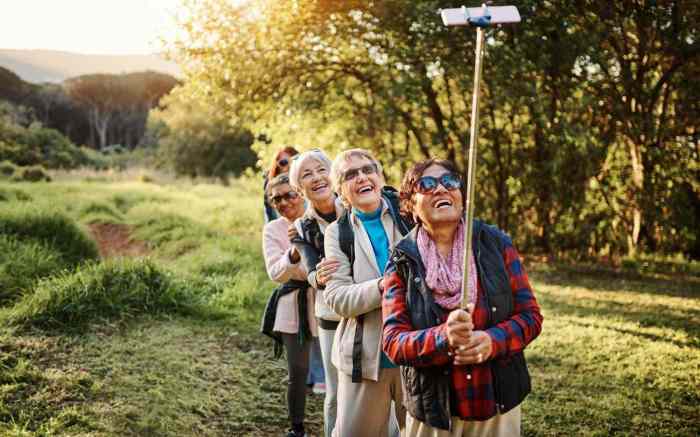Senior Travel Groups represent a booming sector, catering to a demographic increasingly seeking enriching experiences. This exploration delves into the diverse types of groups, popular destinations, logistical considerations, and effective marketing strategies. We examine the unique needs of this audience, highlighting both the opportunities and challenges inherent in this expanding market segment.
From adventure-packed excursions to relaxing cultural immersions, the options for senior travel are vast and varied. Understanding the preferences of this demographic—their activity levels, preferred group sizes, and desired destinations—is crucial for travel providers seeking to capture a share of this lucrative market. This analysis provides insights into creating successful and fulfilling travel experiences tailored specifically to the senior traveler.
Types of Senior Travel Groups

The senior travel market is booming, with diverse offerings catering to a wide spectrum of preferences and activity levels. Understanding the nuances of these groups—from their activity preferences to their demographic profiles—is crucial for both travel providers and prospective travelers. This analysis categorizes senior travel groups based on activity level and group size, highlighting the appeal and typical demographics of each.
Activity Levels and Group Categorization
Senior travel groups are broadly categorized by their activity level, ranging from relaxed itineraries to adventurous expeditions. Relaxation-focused groups prioritize comfort and leisurely activities, often featuring spa treatments, scenic drives, and cultural visits at a slower pace. Adventure-oriented groups, conversely, engage in more physically demanding activities like hiking, kayaking, or even wildlife safaris, demanding a higher level of fitness and stamina.
Finally, culturally-focused groups prioritize immersive experiences, emphasizing historical sites, museums, and local traditions. These groups often involve guided tours and opportunities for interaction with local communities. The choice depends heavily on individual preferences and physical capabilities.
Group Size and its Impact on the Travel Experience
The size of a senior travel group significantly influences the overall experience. Smaller groups (fewer than 10 participants) offer a more intimate and personalized experience, allowing for greater flexibility and interaction among members. Medium-sized groups (10-25 participants) strike a balance between intimacy and logistical efficiency. Larger groups (25+ participants) are often more cost-effective, but may sacrifice some personalization and spontaneity.
The ideal group size depends on the individual’s preference for social interaction and their comfort level with larger crowds.
Demographics of Senior Travel Groups
The demographic profile of senior travelers varies considerably across group types. Relaxation-focused groups often attract a slightly older demographic, with a higher proportion of individuals prioritizing comfort and relaxation. Adventure groups tend to skew towards a younger, more active senior population, with a greater emphasis on physical fitness and a willingness to embrace challenges. Culturally-focused groups draw a diverse range of ages, united by a shared interest in exploring different cultures and histories.
Income levels also play a role; adventure travel, for example, often requires a higher disposable income due to the cost of activities and equipment.
Senior Travel Group Characteristics
| Group Type | Activity Level | Typical Age Range | Average Group Size |
|---|---|---|---|
| Relaxation | Low | 70-85+ | 15-25 |
| Cultural | Moderate | 65-80 | 10-20 |
| Adventure | High | 60-75 | 8-15 |
| Multi-Generational Family | Variable | 50-80+ | 4-12 |
Marketing and Promotion of Senior Travel Groups

Reaching the lucrative senior travel market requires a nuanced approach that speaks directly to the desires and concerns of this demographic. Effective marketing must emphasize value, trust, and ease of travel, while acknowledging the specific needs and preferences of older adults. Ignoring these factors can lead to missed opportunities in a segment known for its significant spending power.
Effective Marketing Strategies for Senior Travelers
Targeting senior travelers necessitates a multi-pronged strategy that leverages various channels and messaging. Print advertising, while seemingly outdated, retains relevance, particularly in publications frequented by the target demographic. Digital marketing, however, offers broader reach and more precise targeting capabilities. Direct mail campaigns, personalized to individual interests and travel preferences, can prove highly effective. Finally, partnerships with organizations serving seniors, such as retirement communities or senior centers, provide access to a concentrated audience.
A well-integrated strategy utilizes a combination of these approaches for maximum impact.
Compelling Marketing Materials for Senior Travel
Brochures designed for senior travel groups should feature large, high-quality images showcasing comfortable accommodations, accessible destinations, and engaging activities. Text should be easy to read, using a clear and concise font size. Crucially, brochures must highlight the value proposition clearly, emphasizing aspects like all-inclusive pricing, manageable itineraries, and accessible transportation. Websites should mirror this accessibility, offering large font options, clear navigation, and detailed information about trip itineraries, accommodation amenities, and cancellation policies.
Testimonials from past travelers, emphasizing positive experiences, add considerable credibility. For example, a brochure might feature a vibrant image of a group enjoying a leisurely afternoon tea in a charming European village, while the website would offer a detailed itinerary with accessible information on each location’s accessibility features.
Social Media Marketing for Senior Travel Groups
Social media presents a unique opportunity to engage with potential senior travelers. Platforms like Facebook and Instagram, with their strong visual focus, are particularly well-suited to showcasing the beauty and ease of senior travel experiences. Using high-quality photos and videos that emphasize relaxation, comfort, and social interaction is key. Targeted advertising on these platforms allows for precise demographic targeting, ensuring that marketing efforts reach the intended audience efficiently.
Regular posting of engaging content, such as travel tips, destination spotlights, and behind-the-scenes glimpses of tour preparations, builds trust and brand loyalty. Responding promptly and personally to comments and inquiries further fosters a sense of community and personalized service.
Sample Social Media Post: Senior Travel Group Tour
Image Description: A sun-drenched photograph depicting a group of smiling seniors enjoying a guided tour of a picturesque Tuscan vineyard. They are seated around a rustic table, tasting local wine and sharing laughter. The background features rolling hills, lush vineyards, and a clear blue sky. The overall feeling is one of relaxed enjoyment and camaraderie. Post Text: “Escape to Tuscany with our exclusive Senior Travel Group tour! Explore charming villages, savor authentic Italian cuisine, and enjoy breathtaking vineyard views.
Limited spaces available. Book your unforgettable adventure today! [Link to booking page]”
Challenges and Opportunities in Senior Travel
The burgeoning senior travel market presents a unique confluence of challenges and opportunities for travel companies. Understanding the specific needs and concerns of this demographic is crucial for success, requiring a nuanced approach that goes beyond simply offering discounted rates. Failure to address these challenges can lead to lost revenue and reputational damage, while effectively leveraging the opportunities can yield significant returns.
Common Challenges Faced by Senior Travelers and Mitigation Strategies
Senior travelers often face unique challenges that younger travelers may not encounter. These can range from physical limitations and health concerns to anxieties about navigating unfamiliar environments and managing complex travel logistics. Travel groups can mitigate these challenges through proactive planning and tailored services. For example, groups should prioritize accessible accommodations, offer assistance with baggage handling, and provide clear and concise itineraries.
Pre-trip briefings that address potential concerns and offer practical advice can also significantly enhance the travel experience. Furthermore, including options for flexible pacing and rest periods acknowledges the diverse physical capabilities within the group.
Opportunities Presented by the Growing Senior Travel Market
The global senior population is expanding rapidly, creating a substantial and increasingly lucrative travel market. This demographic represents a significant spending power and a desire for enriching travel experiences. Companies that cater to the specific needs and preferences of senior travelers stand to gain a considerable competitive advantage. For instance, specializing in curated itineraries focusing on cultural immersion, historical sites, or wellness activities can attract this discerning market segment.
Marketing campaigns should emphasize the value proposition of stress-free travel, personalized service, and opportunities for social interaction and new experiences. Consider the success of companies specializing in escorted tours targeting specific interests, like historical reenactments or culinary explorations, which tap into the desire for enriching and engaging travel experiences amongst seniors.
Inclusivity and Accessibility in Senior Travel Group Offerings
Inclusivity and accessibility are paramount in designing senior travel group offerings. This necessitates providing options for travelers with varying levels of mobility, cognitive abilities, and sensory needs. Travel companies should invest in accessible transportation, accommodations, and activities, ensuring that all participants can fully engage in the experience. Consider the impact of offering wheelchair-accessible transportation, providing visual and auditory aids for those with sensory impairments, and employing staff trained in assisting travelers with diverse needs.
This commitment to inclusivity not only caters to a wider range of travelers but also strengthens the brand’s reputation for social responsibility and customer care.
Adapting Services to Meet the Specific Needs of Senior Travelers
Adapting services to meet the specific needs of senior travelers involves a multifaceted approach. This includes offering travel insurance options tailored to the age group, providing clear and easily accessible information, and ensuring prompt and efficient customer service. Travel itineraries should incorporate ample time for rest and relaxation, and activities should be appropriately paced and physically manageable.
The provision of medical assistance resources and emergency contact information further demonstrates a commitment to the well-being of senior travelers. For example, partnering with local healthcare providers to establish emergency protocols can greatly enhance traveler safety and confidence. Similarly, providing detailed health and safety information before and during the trip reduces anxiety and increases preparedness.
The senior travel market presents a significant opportunity for growth and innovation within the tourism industry. By understanding the specific needs and desires of this demographic—and by addressing the challenges they face—travel companies can create truly rewarding experiences that cater to a discerning and growing clientele. The key lies in offering inclusive, accessible, and well-planned itineraries that prioritize safety, comfort, and enriching cultural immersion.

